International Trade Policies: A Comparison of Australia, China, USA
VerifiedAdded on 2023/04/06
|7
|1184
|283
Report
AI Summary
This report provides a comprehensive analysis and comparison of the trade policies of Australia, China, and the USA, utilizing the Heckscher-Ohlin model to evaluate international trade dynamics. It examines the strengths and weaknesses of each country's approach, highlighting the impact of factors such as comparative costs, factor endowments, and trade agreements. The report also addresses the ongoing trade war between China and the USA and its potential repercussions for the Australian economy, emphasizing the risks faced by Australian exporters. Ultimately, the report offers valuable insights into global trade policies and their implications, serving as a valuable resource for researchers and students alike. Desklib provides access to this report along with a vast library of academic resources.
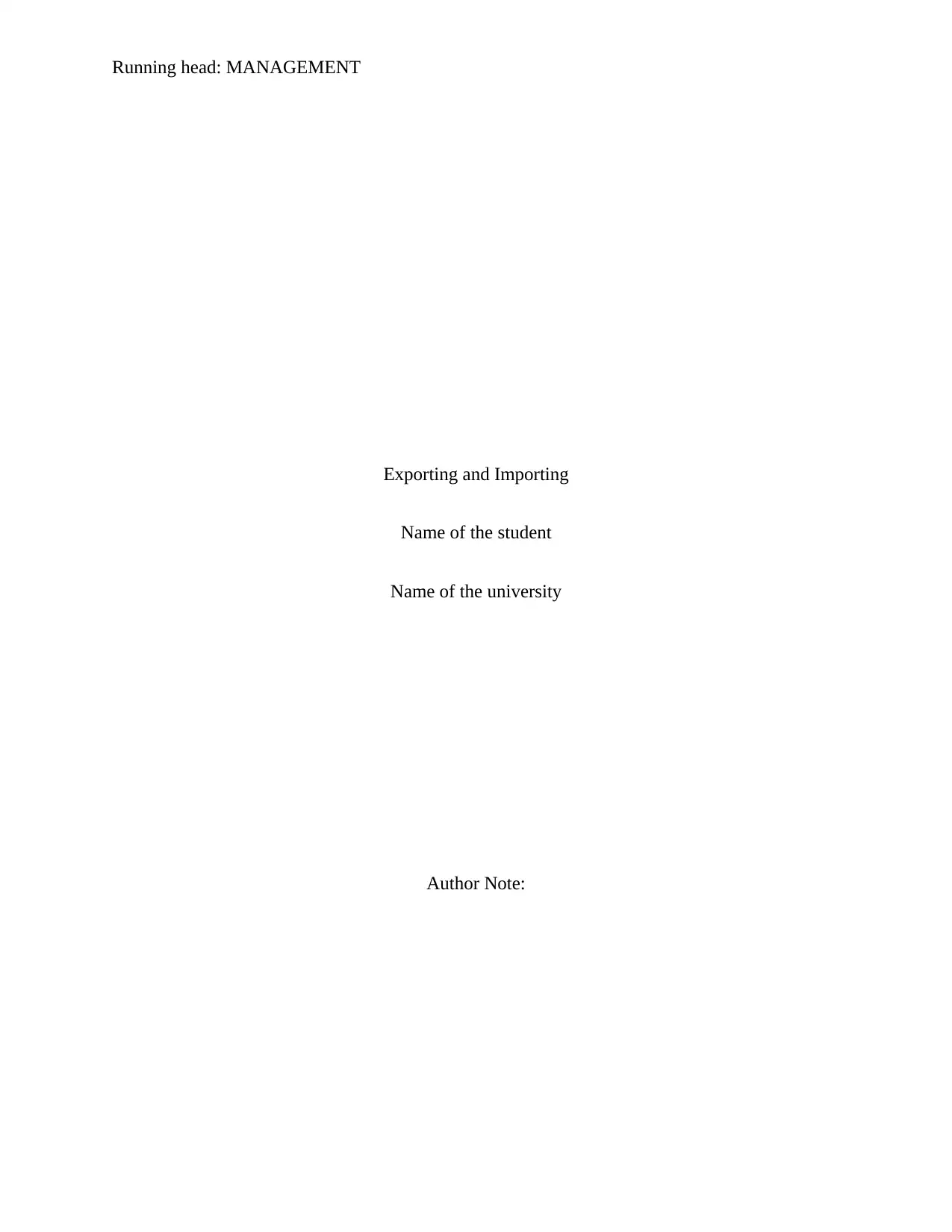
Running head: MANAGEMENT
Exporting and Importing
Name of the student
Name of the university
Author Note:
Exporting and Importing
Name of the student
Name of the university
Author Note:
Paraphrase This Document
Need a fresh take? Get an instant paraphrase of this document with our AI Paraphraser
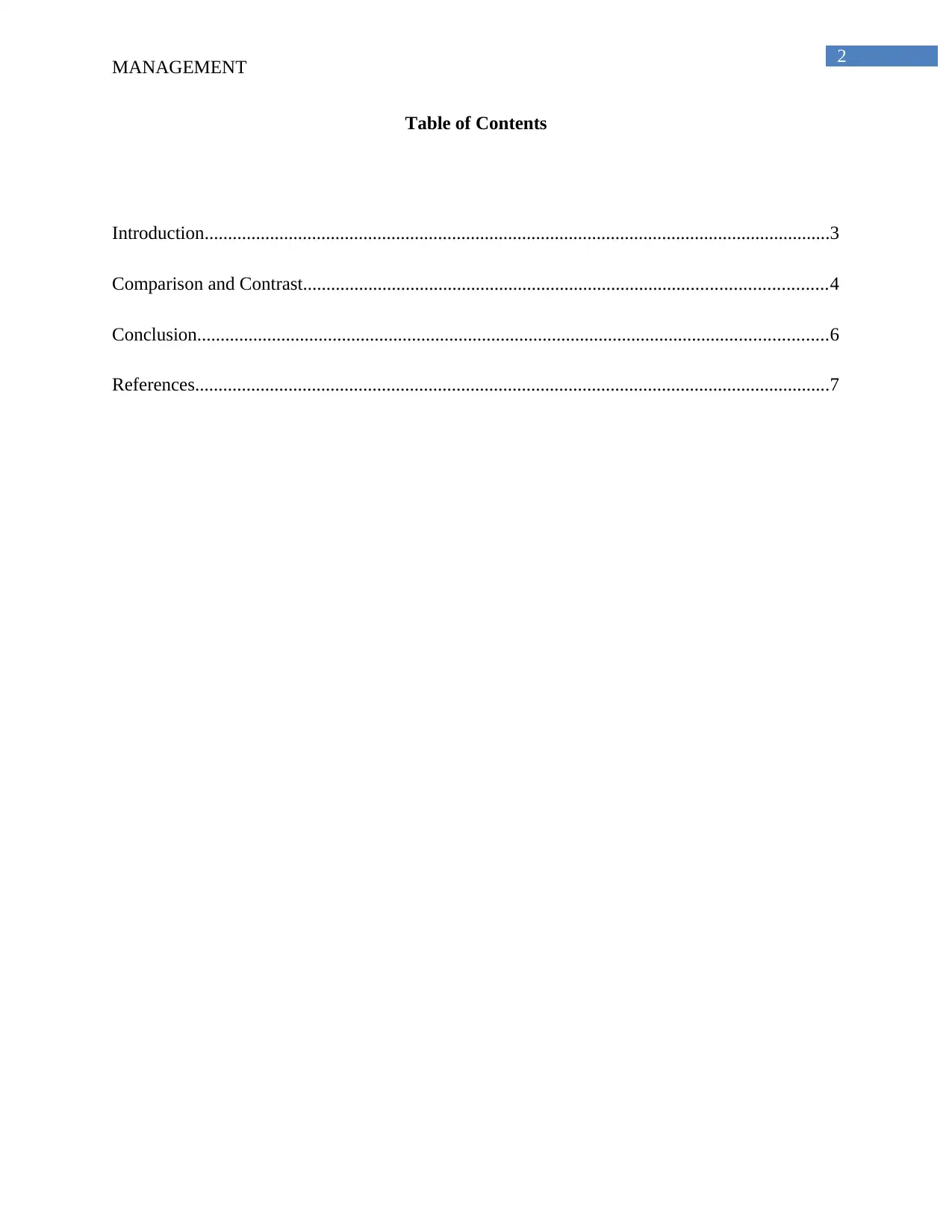
2
MANAGEMENT
Table of Contents
Introduction......................................................................................................................................3
Comparison and Contrast................................................................................................................4
Conclusion.......................................................................................................................................6
References........................................................................................................................................7
MANAGEMENT
Table of Contents
Introduction......................................................................................................................................3
Comparison and Contrast................................................................................................................4
Conclusion.......................................................................................................................................6
References........................................................................................................................................7
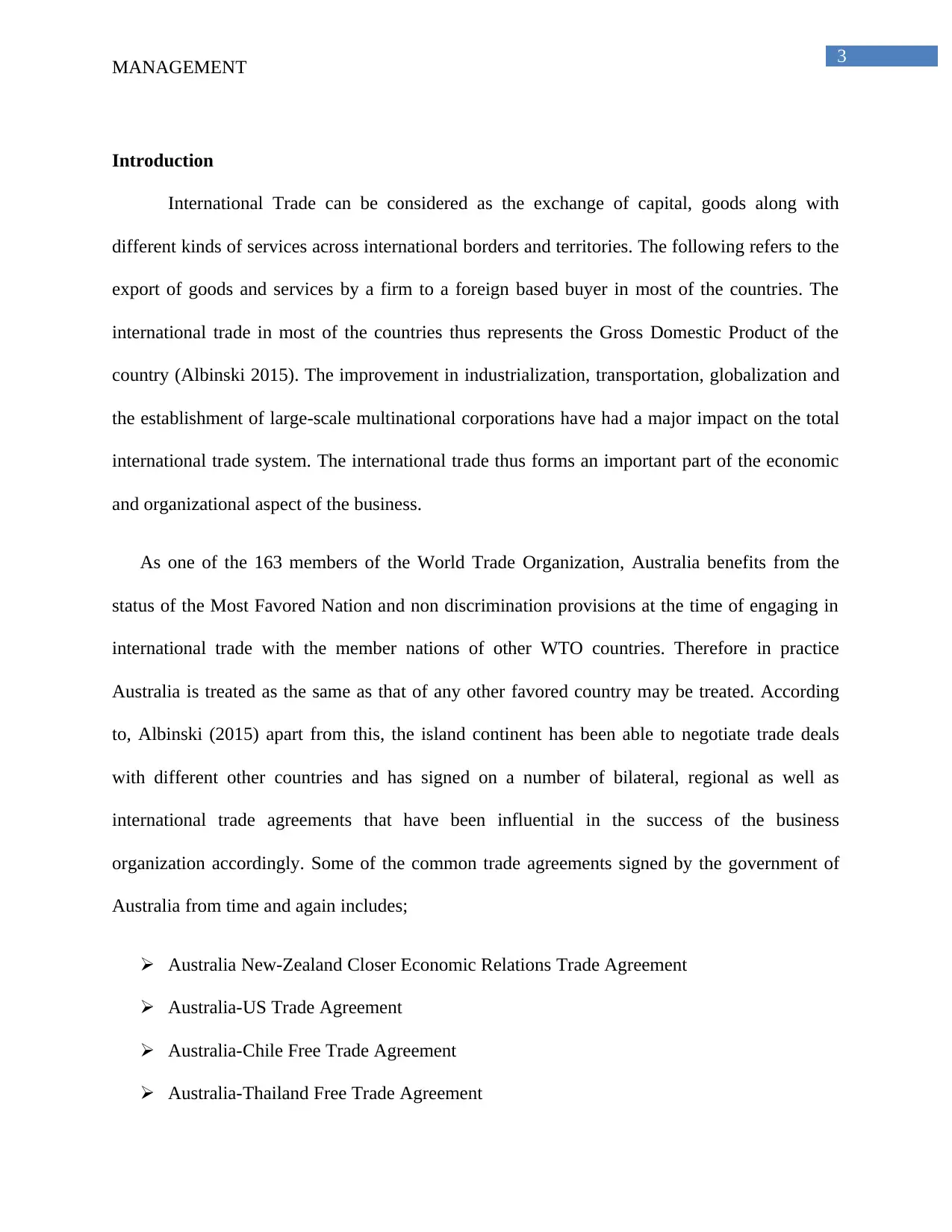
3
MANAGEMENT
Introduction
International Trade can be considered as the exchange of capital, goods along with
different kinds of services across international borders and territories. The following refers to the
export of goods and services by a firm to a foreign based buyer in most of the countries. The
international trade in most of the countries thus represents the Gross Domestic Product of the
country (Albinski 2015). The improvement in industrialization, transportation, globalization and
the establishment of large-scale multinational corporations have had a major impact on the total
international trade system. The international trade thus forms an important part of the economic
and organizational aspect of the business.
As one of the 163 members of the World Trade Organization, Australia benefits from the
status of the Most Favored Nation and non discrimination provisions at the time of engaging in
international trade with the member nations of other WTO countries. Therefore in practice
Australia is treated as the same as that of any other favored country may be treated. According
to, Albinski (2015) apart from this, the island continent has been able to negotiate trade deals
with different other countries and has signed on a number of bilateral, regional as well as
international trade agreements that have been influential in the success of the business
organization accordingly. Some of the common trade agreements signed by the government of
Australia from time and again includes;
Australia New-Zealand Closer Economic Relations Trade Agreement
Australia-US Trade Agreement
Australia-Chile Free Trade Agreement
Australia-Thailand Free Trade Agreement
MANAGEMENT
Introduction
International Trade can be considered as the exchange of capital, goods along with
different kinds of services across international borders and territories. The following refers to the
export of goods and services by a firm to a foreign based buyer in most of the countries. The
international trade in most of the countries thus represents the Gross Domestic Product of the
country (Albinski 2015). The improvement in industrialization, transportation, globalization and
the establishment of large-scale multinational corporations have had a major impact on the total
international trade system. The international trade thus forms an important part of the economic
and organizational aspect of the business.
As one of the 163 members of the World Trade Organization, Australia benefits from the
status of the Most Favored Nation and non discrimination provisions at the time of engaging in
international trade with the member nations of other WTO countries. Therefore in practice
Australia is treated as the same as that of any other favored country may be treated. According
to, Albinski (2015) apart from this, the island continent has been able to negotiate trade deals
with different other countries and has signed on a number of bilateral, regional as well as
international trade agreements that have been influential in the success of the business
organization accordingly. Some of the common trade agreements signed by the government of
Australia from time and again includes;
Australia New-Zealand Closer Economic Relations Trade Agreement
Australia-US Trade Agreement
Australia-Chile Free Trade Agreement
Australia-Thailand Free Trade Agreement
⊘ This is a preview!⊘
Do you want full access?
Subscribe today to unlock all pages.

Trusted by 1+ million students worldwide
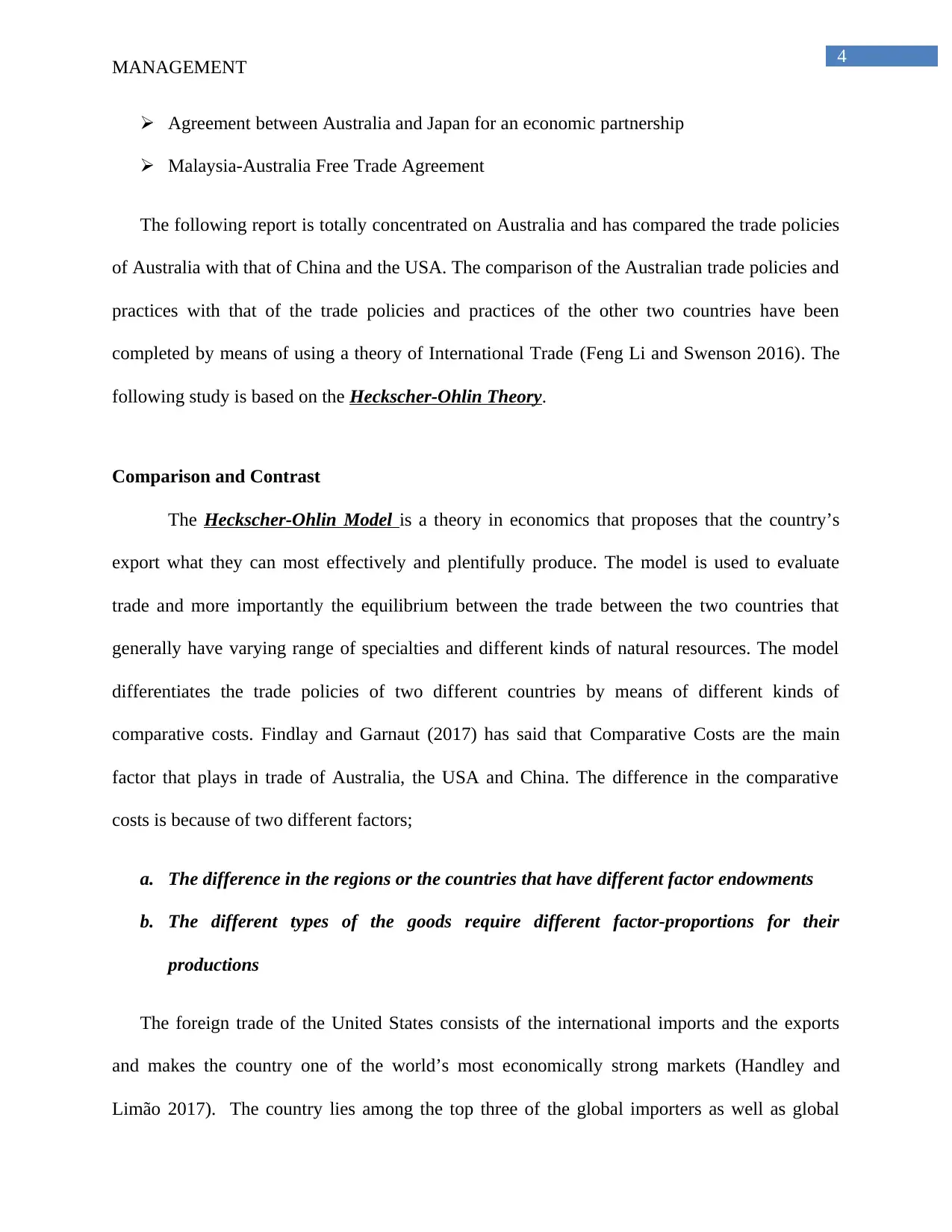
4
MANAGEMENT
Agreement between Australia and Japan for an economic partnership
Malaysia-Australia Free Trade Agreement
The following report is totally concentrated on Australia and has compared the trade policies
of Australia with that of China and the USA. The comparison of the Australian trade policies and
practices with that of the trade policies and practices of the other two countries have been
completed by means of using a theory of International Trade (Feng Li and Swenson 2016). The
following study is based on the Heckscher-Ohlin Theory.
Comparison and Contrast
The Heckscher-Ohlin Model is a theory in economics that proposes that the country’s
export what they can most effectively and plentifully produce. The model is used to evaluate
trade and more importantly the equilibrium between the trade between the two countries that
generally have varying range of specialties and different kinds of natural resources. The model
differentiates the trade policies of two different countries by means of different kinds of
comparative costs. Findlay and Garnaut (2017) has said that Comparative Costs are the main
factor that plays in trade of Australia, the USA and China. The difference in the comparative
costs is because of two different factors;
a. The difference in the regions or the countries that have different factor endowments
b. The different types of the goods require different factor-proportions for their
productions
The foreign trade of the United States consists of the international imports and the exports
and makes the country one of the world’s most economically strong markets (Handley and
Limão 2017). The country lies among the top three of the global importers as well as global
MANAGEMENT
Agreement between Australia and Japan for an economic partnership
Malaysia-Australia Free Trade Agreement
The following report is totally concentrated on Australia and has compared the trade policies
of Australia with that of China and the USA. The comparison of the Australian trade policies and
practices with that of the trade policies and practices of the other two countries have been
completed by means of using a theory of International Trade (Feng Li and Swenson 2016). The
following study is based on the Heckscher-Ohlin Theory.
Comparison and Contrast
The Heckscher-Ohlin Model is a theory in economics that proposes that the country’s
export what they can most effectively and plentifully produce. The model is used to evaluate
trade and more importantly the equilibrium between the trade between the two countries that
generally have varying range of specialties and different kinds of natural resources. The model
differentiates the trade policies of two different countries by means of different kinds of
comparative costs. Findlay and Garnaut (2017) has said that Comparative Costs are the main
factor that plays in trade of Australia, the USA and China. The difference in the comparative
costs is because of two different factors;
a. The difference in the regions or the countries that have different factor endowments
b. The different types of the goods require different factor-proportions for their
productions
The foreign trade of the United States consists of the international imports and the exports
and makes the country one of the world’s most economically strong markets (Handley and
Limão 2017). The country lies among the top three of the global importers as well as global
Paraphrase This Document
Need a fresh take? Get an instant paraphrase of this document with our AI Paraphraser
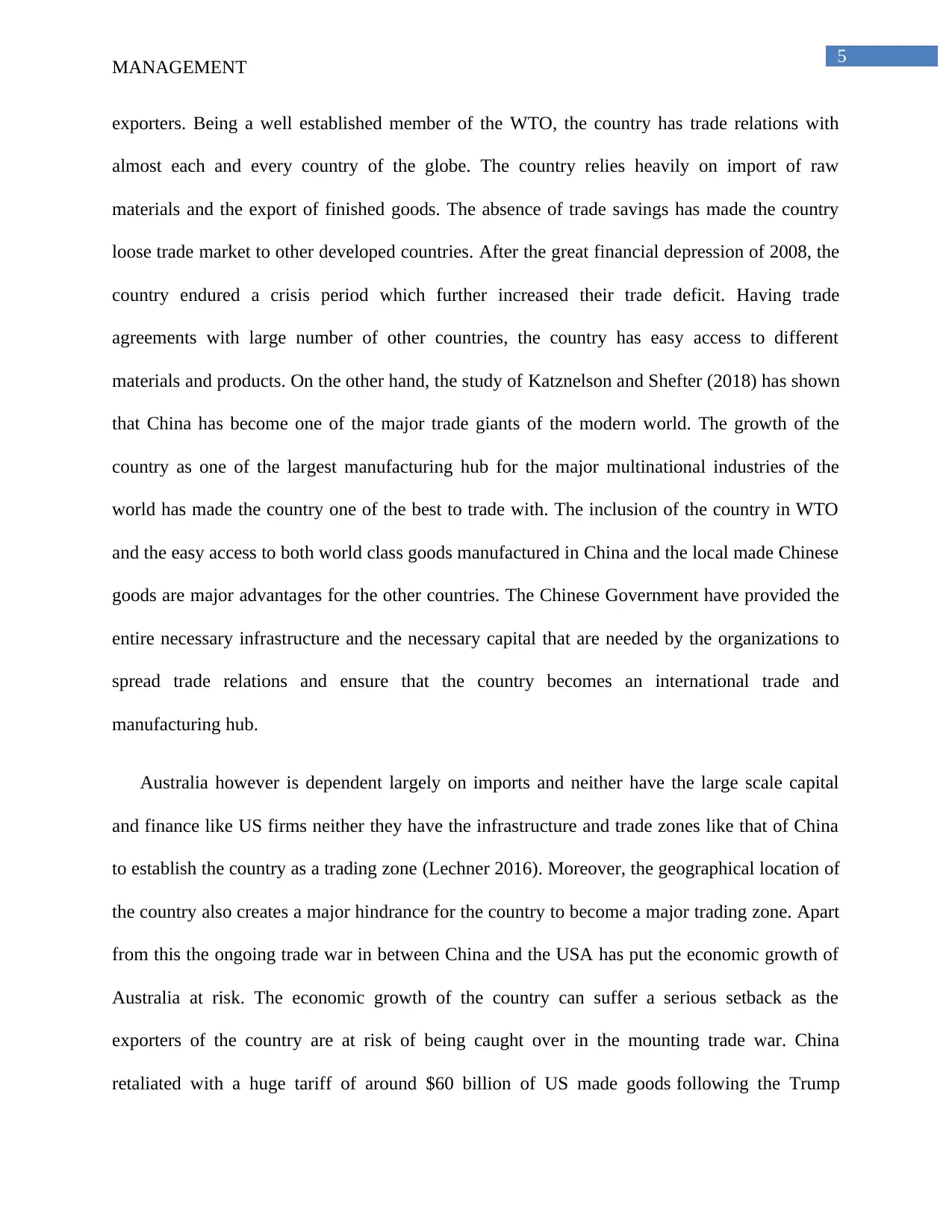
5
MANAGEMENT
exporters. Being a well established member of the WTO, the country has trade relations with
almost each and every country of the globe. The country relies heavily on import of raw
materials and the export of finished goods. The absence of trade savings has made the country
loose trade market to other developed countries. After the great financial depression of 2008, the
country endured a crisis period which further increased their trade deficit. Having trade
agreements with large number of other countries, the country has easy access to different
materials and products. On the other hand, the study of Katznelson and Shefter (2018) has shown
that China has become one of the major trade giants of the modern world. The growth of the
country as one of the largest manufacturing hub for the major multinational industries of the
world has made the country one of the best to trade with. The inclusion of the country in WTO
and the easy access to both world class goods manufactured in China and the local made Chinese
goods are major advantages for the other countries. The Chinese Government have provided the
entire necessary infrastructure and the necessary capital that are needed by the organizations to
spread trade relations and ensure that the country becomes an international trade and
manufacturing hub.
Australia however is dependent largely on imports and neither have the large scale capital
and finance like US firms neither they have the infrastructure and trade zones like that of China
to establish the country as a trading zone (Lechner 2016). Moreover, the geographical location of
the country also creates a major hindrance for the country to become a major trading zone. Apart
from this the ongoing trade war in between China and the USA has put the economic growth of
Australia at risk. The economic growth of the country can suffer a serious setback as the
exporters of the country are at risk of being caught over in the mounting trade war. China
retaliated with a huge tariff of around $60 billion of US made goods following the Trump
MANAGEMENT
exporters. Being a well established member of the WTO, the country has trade relations with
almost each and every country of the globe. The country relies heavily on import of raw
materials and the export of finished goods. The absence of trade savings has made the country
loose trade market to other developed countries. After the great financial depression of 2008, the
country endured a crisis period which further increased their trade deficit. Having trade
agreements with large number of other countries, the country has easy access to different
materials and products. On the other hand, the study of Katznelson and Shefter (2018) has shown
that China has become one of the major trade giants of the modern world. The growth of the
country as one of the largest manufacturing hub for the major multinational industries of the
world has made the country one of the best to trade with. The inclusion of the country in WTO
and the easy access to both world class goods manufactured in China and the local made Chinese
goods are major advantages for the other countries. The Chinese Government have provided the
entire necessary infrastructure and the necessary capital that are needed by the organizations to
spread trade relations and ensure that the country becomes an international trade and
manufacturing hub.
Australia however is dependent largely on imports and neither have the large scale capital
and finance like US firms neither they have the infrastructure and trade zones like that of China
to establish the country as a trading zone (Lechner 2016). Moreover, the geographical location of
the country also creates a major hindrance for the country to become a major trading zone. Apart
from this the ongoing trade war in between China and the USA has put the economic growth of
Australia at risk. The economic growth of the country can suffer a serious setback as the
exporters of the country are at risk of being caught over in the mounting trade war. China
retaliated with a huge tariff of around $60 billion of US made goods following the Trump
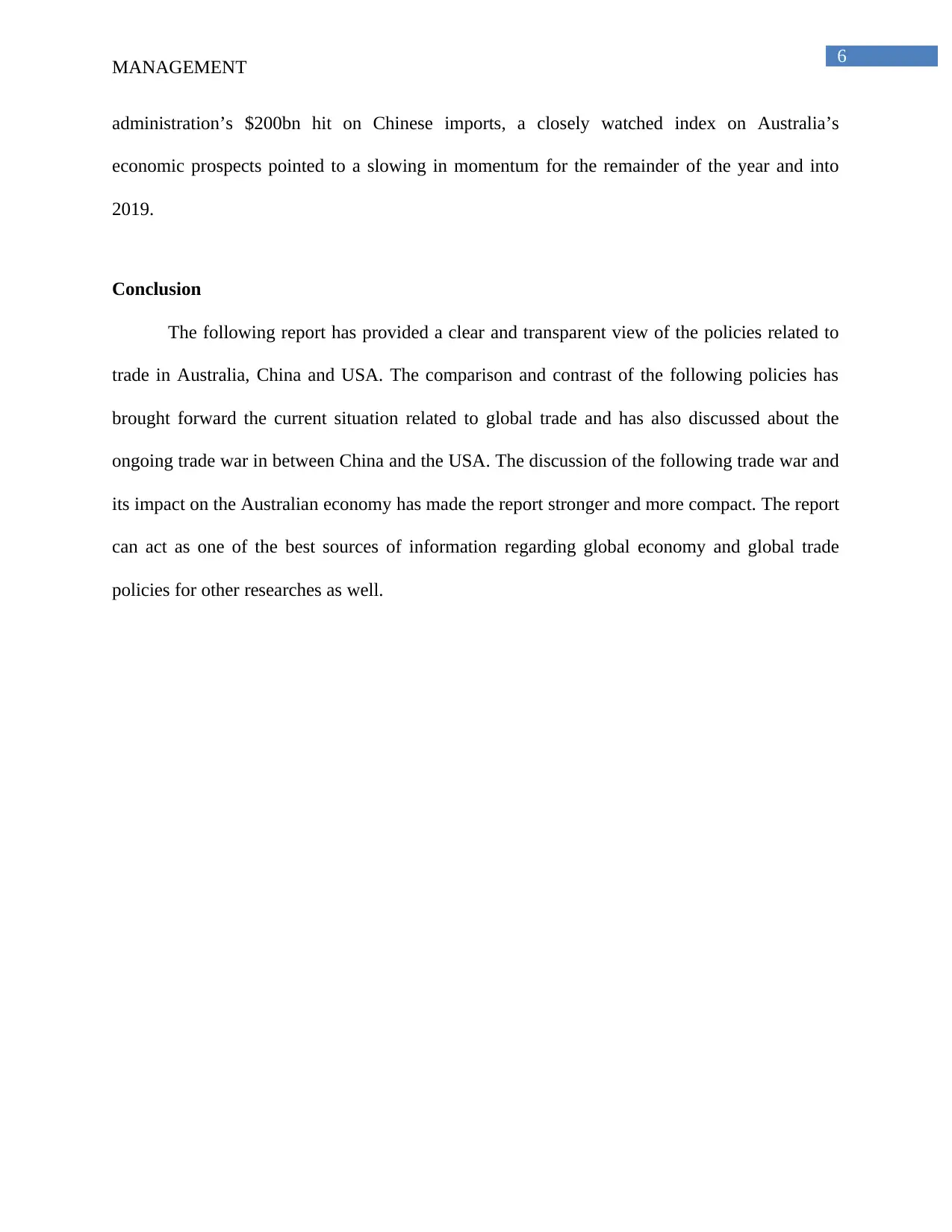
6
MANAGEMENT
administration’s $200bn hit on Chinese imports, a closely watched index on Australia’s
economic prospects pointed to a slowing in momentum for the remainder of the year and into
2019.
Conclusion
The following report has provided a clear and transparent view of the policies related to
trade in Australia, China and USA. The comparison and contrast of the following policies has
brought forward the current situation related to global trade and has also discussed about the
ongoing trade war in between China and the USA. The discussion of the following trade war and
its impact on the Australian economy has made the report stronger and more compact. The report
can act as one of the best sources of information regarding global economy and global trade
policies for other researches as well.
MANAGEMENT
administration’s $200bn hit on Chinese imports, a closely watched index on Australia’s
economic prospects pointed to a slowing in momentum for the remainder of the year and into
2019.
Conclusion
The following report has provided a clear and transparent view of the policies related to
trade in Australia, China and USA. The comparison and contrast of the following policies has
brought forward the current situation related to global trade and has also discussed about the
ongoing trade war in between China and the USA. The discussion of the following trade war and
its impact on the Australian economy has made the report stronger and more compact. The report
can act as one of the best sources of information regarding global economy and global trade
policies for other researches as well.
⊘ This is a preview!⊘
Do you want full access?
Subscribe today to unlock all pages.

Trusted by 1+ million students worldwide
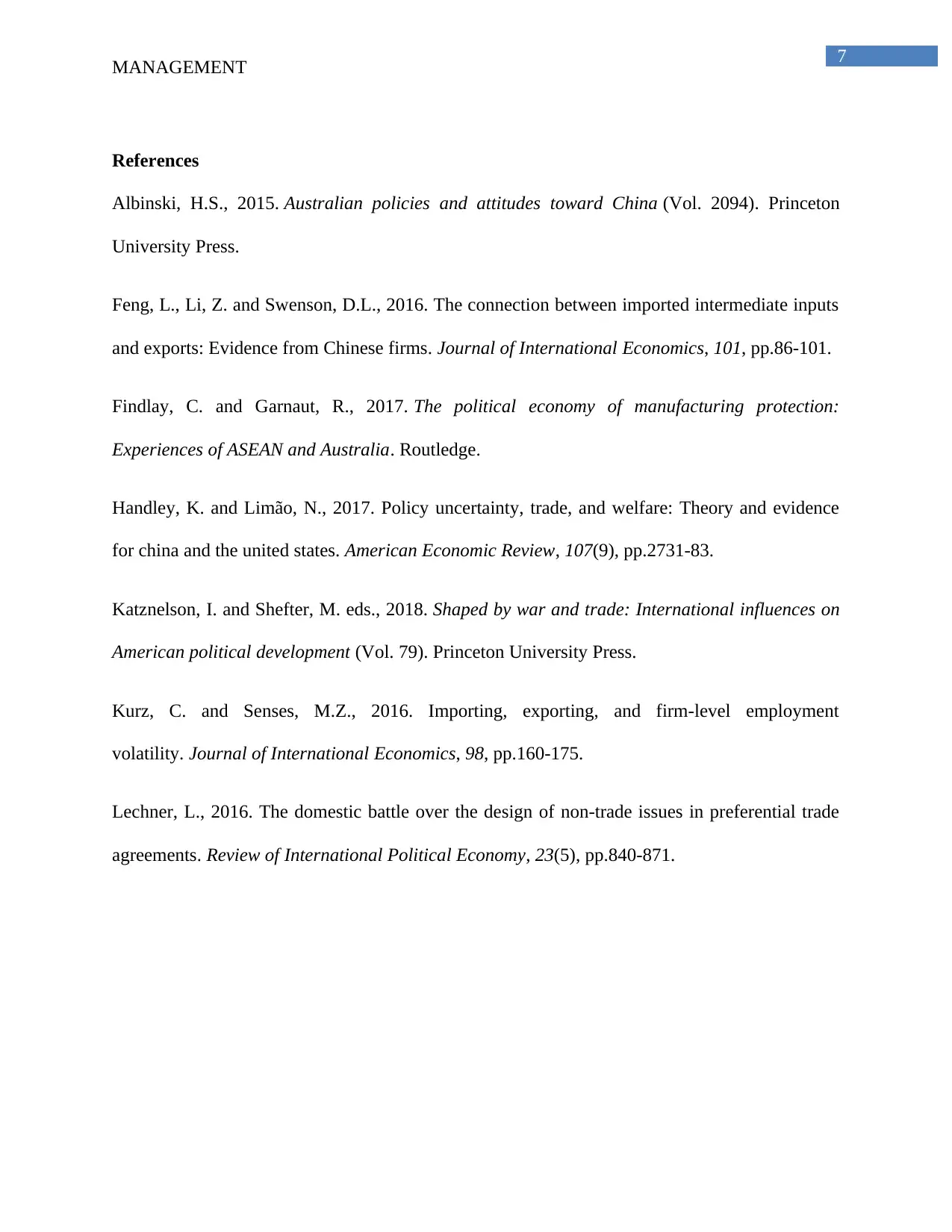
7
MANAGEMENT
References
Albinski, H.S., 2015. Australian policies and attitudes toward China (Vol. 2094). Princeton
University Press.
Feng, L., Li, Z. and Swenson, D.L., 2016. The connection between imported intermediate inputs
and exports: Evidence from Chinese firms. Journal of International Economics, 101, pp.86-101.
Findlay, C. and Garnaut, R., 2017. The political economy of manufacturing protection:
Experiences of ASEAN and Australia. Routledge.
Handley, K. and Limão, N., 2017. Policy uncertainty, trade, and welfare: Theory and evidence
for china and the united states. American Economic Review, 107(9), pp.2731-83.
Katznelson, I. and Shefter, M. eds., 2018. Shaped by war and trade: International influences on
American political development (Vol. 79). Princeton University Press.
Kurz, C. and Senses, M.Z., 2016. Importing, exporting, and firm-level employment
volatility. Journal of International Economics, 98, pp.160-175.
Lechner, L., 2016. The domestic battle over the design of non-trade issues in preferential trade
agreements. Review of International Political Economy, 23(5), pp.840-871.
MANAGEMENT
References
Albinski, H.S., 2015. Australian policies and attitudes toward China (Vol. 2094). Princeton
University Press.
Feng, L., Li, Z. and Swenson, D.L., 2016. The connection between imported intermediate inputs
and exports: Evidence from Chinese firms. Journal of International Economics, 101, pp.86-101.
Findlay, C. and Garnaut, R., 2017. The political economy of manufacturing protection:
Experiences of ASEAN and Australia. Routledge.
Handley, K. and Limão, N., 2017. Policy uncertainty, trade, and welfare: Theory and evidence
for china and the united states. American Economic Review, 107(9), pp.2731-83.
Katznelson, I. and Shefter, M. eds., 2018. Shaped by war and trade: International influences on
American political development (Vol. 79). Princeton University Press.
Kurz, C. and Senses, M.Z., 2016. Importing, exporting, and firm-level employment
volatility. Journal of International Economics, 98, pp.160-175.
Lechner, L., 2016. The domestic battle over the design of non-trade issues in preferential trade
agreements. Review of International Political Economy, 23(5), pp.840-871.
1 out of 7
Related Documents
Your All-in-One AI-Powered Toolkit for Academic Success.
+13062052269
info@desklib.com
Available 24*7 on WhatsApp / Email
![[object Object]](/_next/static/media/star-bottom.7253800d.svg)
Unlock your academic potential
Copyright © 2020–2025 A2Z Services. All Rights Reserved. Developed and managed by ZUCOL.




